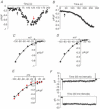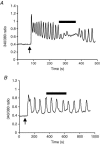Agonist activation of arachidonate-regulated Ca2+-selective (ARC) channels in murine parotid and pancreatic acinar cells
- PMID: 15760932
- PMCID: PMC1464460
- DOI: 10.1113/jphysiol.2005.085704
Agonist activation of arachidonate-regulated Ca2+-selective (ARC) channels in murine parotid and pancreatic acinar cells
Abstract
ARC channels (arachidonate-regulated Ca(2+)-selective channels) are a novel type of highly Ca(2+)-selective channel that are specifically activated by low concentrations of agonist-induced arachidonic acid. This activation occurs in the absence of any depletion of internal Ca(2+) stores (i.e. they are 'non-capacitative'). Previous studies in HEK293 cells have shown that these channels provide the predominant pathway for the entry of Ca(2+) seen at low agonist concentrations where oscillatory [Ca(2+)](i) signals are typically produced. In contrast, activation of the more widely studied store-operated Ca(2+) channels (e.g. CRAC channels) is only seen at higher agonist concentrations where sustained 'plateau-type'[Ca(2+)](i) responses are observed. We have now demonstrated the presence of ARC channels in both parotid and pancreatic acinar cells and shown that, again, they are specifically activated by the low concentrations of appropriate agonists (carbachol in the parotid, and both carbachol and cholecystokinin in the pancreas) that are associated with oscillatory [Ca(2+)](i) signals in these cells. Uncoupling the receptor-mediated activation of cytosolic phospholipase A(2) (cPLA(2)) with isotetrandrine reduces the activation of the ARC channels by carbachol and, correspondingly, markedly inhibits the [Ca(2+)](i) signals induced by low carbachol concentrations, whilst those signals seen at high agonist concentrations are essentially unaffected. Interestingly, in the pancreatic acinar cells, activation by cholecystokinin induces a current through the ARC channels that is only approximately 60% of that seen with carbachol. This is consistent with previous reports indicating that carbachol-induced [Ca(2+)](i) signals in these cells are much more dependent on Ca(2+) entry than are the cholecystokinin-induced responses.
Figures






Similar articles
-
ARC channels: a novel pathway for receptor-activated calcium entry.Physiology (Bethesda). 2004 Dec;19:355-61. doi: 10.1152/physiol.00018.2004. Physiology (Bethesda). 2004. PMID: 15546853 Review.
-
Orai channel-dependent activation of phospholipase C-δ: a novel mechanism for the effects of calcium entry on calcium oscillations.J Physiol. 2011 Nov 1;589(Pt 21):5057-69. doi: 10.1113/jphysiol.2011.214437. Epub 2011 Aug 30. J Physiol. 2011. PMID: 21878525 Free PMC article.
-
Ca2+ selectivity and fatty acid specificity of the noncapacitative, arachidonate-regulated Ca2+ (ARC) channels.J Biol Chem. 2003 Mar 21;278(12):10174-81. doi: 10.1074/jbc.M212536200. Epub 2003 Jan 9. J Biol Chem. 2003. PMID: 12522216
-
I(ARC), a novel arachidonate-regulated, noncapacitative Ca(2+) entry channel.J Biol Chem. 2000 Mar 31;275(13):9114-9. doi: 10.1074/jbc.275.13.9114. J Biol Chem. 2000. PMID: 10734044
-
Calcium entry and the control of calcium oscillations.Biochem Soc Trans. 2003 Oct;31(Pt 5):916-9. doi: 10.1042/bst0310916. Biochem Soc Trans. 2003. PMID: 14505448 Review.
Cited by
-
New molecular players in capacitative Ca2+ entry.J Cell Sci. 2007 Jun 15;120(Pt 12):1959-65. doi: 10.1242/jcs.03462. Epub 2007 May 3. J Cell Sci. 2007. PMID: 17478524 Free PMC article.
-
Molecular mechanisms of caffeine-mediated intestinal epithelial ion transports.Br J Pharmacol. 2019 Jun;176(11):1700-1716. doi: 10.1111/bph.14640. Epub 2019 Apr 11. Br J Pharmacol. 2019. PMID: 30808064 Free PMC article.
-
Phosphorylation-mediated structural changes within the SOAR domain of stromal interaction molecule 1 enable specific activation of distinct Orai channels.J Biol Chem. 2018 Mar 2;293(9):3145-3155. doi: 10.1074/jbc.M117.819078. Epub 2018 Jan 11. J Biol Chem. 2018. PMID: 29326165 Free PMC article.
-
High extracellular Ca2+ stimulates Ca2+-activated Cl- currents in frog parathyroid cells through the mediation of arachidonic acid cascade.PLoS One. 2011 Apr 29;6(4):e19158. doi: 10.1371/journal.pone.0019158. PLoS One. 2011. PMID: 21559478 Free PMC article.
-
Arachidonic acid and ion channels: an update.Br J Pharmacol. 2008 Sep;155(1):4-16. doi: 10.1038/bjp.2008.216. Epub 2008 Jun 16. Br J Pharmacol. 2008. PMID: 18552881 Free PMC article. Review.
References
-
- Akiba S, Kato E, Sato T, Fujii T. Biscoclaurine alkaloids inhibit receptor-mediated phospholipase A2 activation probably through uncoupling of a GTP-binding protein from the enzyme in rat peritoneal mast cells. Biochem Pharmacol. 1992;44:45–50. 10.1016/0006-2952(92)90036-I. - DOI - PubMed
-
- Begenisich T, Nakamoto T, Ovitt CE, Nehrke K, Brugnara C, Alper SL, Melvin JE. Physiological roles of the intermediate conductance, Ca2+-activated potassium channel Kcnn4. J Biol Chem. 2004;279:47681–47687. - PubMed
-
- Bers DM, Patton CW, Nuccitelli R. A practical guide to the preparation of Ca2+ buffers. Meths Cell Biol. 1994;40:1–29. - PubMed
Publication types
MeSH terms
Substances
Grants and funding
LinkOut - more resources
Full Text Sources
Miscellaneous

